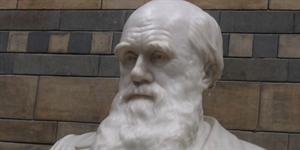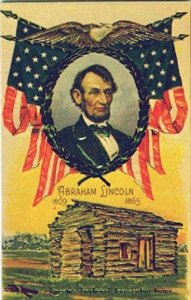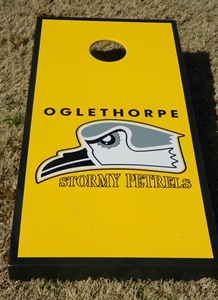Paul Bunyan Day 2025 is on Wednesday, February 12, 2025: What State did Paul Bunyan Come From?
Wednesday, February 12, 2025 is Paul Bunyan Day 2025. Paul Bunyan - Wikipedia, the free encyclopedia see Paul Bunyan and Babe
As an Amazon Associate I earn from qualifying purchases.

Bunyan Tall Tales
In our fourth grade reading class we read "Paul Bunyan's Cornstalk," a story retold by Harold Courlander. As you may remember from stories you read about this famous lumberjack, Paul Bunyan never did anything in a small way. In "Paul Bunyan's Cornstalk," he planted a vegetable garden that caused a terrible drought. The corn and pumpkin roots he planted in his garden soaked up all the water for over 60 miles around. With the help of Babe, the blue ox, Paul was able to pull out the pumpkin vine. To stop the cornstalk from growing, however, he had to climb the stalk (which took him two and a half days) and lob off the top.
We learned that one of the things that makes a tall tale "tall" is exaggeration. Adventure and humor are also distinguishing characteristics of tall tales. We wrote our own tales about Paul Bunyan.
To our visitors: please keep checking this page. More tales will be added in the very near future.
Paul Bunyan and Babe Create the
Grand Canyon!
by Jozy
One day Paul Bunyan and Babe his blue ox, wanted to plant trees. They picked the best spot ever but it had a whole bunch of trees already there so before he could plant any new trees. Then Paul cut down the old trees that were in his spot where he wanted to plant trees. After he got done cutting trees down he needed to dig holes next. But he did not have a shovel. So he called “Babe”and Babe came and after Babe got there Paul hooked Babe up to a plow and Babe took off so fast and Babe’s feet hit the ground so hard and the plow did to it made the Grand Canyon. The Grand Canyon was 4 miles wide and 200 miles long and that's how Babe made the Grand Canyon.
Babe and Paul Create the Grand Canyon and the Colorado River
by Kelsey
Once upon a time Paul Bunyan, the lumberjack, and Babe the blue ox, went to the Southwest to plow where some trees of Paul’s used to grow.
The next morning they went to where the trees grew. Paul hooked Babe up to the plow. Babe took off so quietly and was so quick that he was like a bolt of lightning. Before Paul even knew it Babe was gone. Paul turned around and there, directly behind him was a very deep hole. He said, “Hey, I can make something out of this.” “I can make it the Grand Canyon.” “Well you know I have such a wonderful hole here that I just need to add water.” “But what if I had the Colorado River run through the Grand Canyon.” Paul thought and thought and came up with an idea. “I know, he said. “I a-a-a-a-choooo” Paul sneezed. When he opened his eyes there was hole from sneezing. “Aha this can be my Colorado River. All I have to do is add a little water and then it will be good as new. That’s how Babe and Paul made the Grand Canyan and the Colorado River.
Paul Bunyan Created
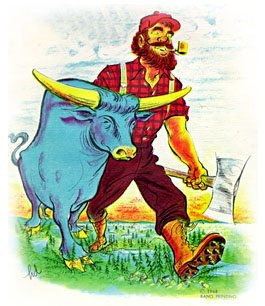
Was Paul Bunyon real?
The short answer is no. The stories of Paul Bunyan are relatively new.
Paul Bunyan, like Pecos Bill, John Henry, and Davy Crockett, to name a few, is one of America's "tall tales," a genre of folklore that is unique to America. Tall tales usually consist of exaggerated heroes and etiological "just so stories."
Paul Bunyan is a giant who, with his enormous blue ox named Babe quite literally shaped North America and led their logging crew of colourful characters about Eastern United states and Canada. The stories and legends of this man appear older than they really are, being written down in the earlier twentieth century.
From Wikipedia:
"According to writer James Stevens in his 1925 book Paul Bunyan, French Canadians gave birth to the tales during the Papineau Rebellion of 1837, when they revolted against the young English Queen. This, some have thought, would probably explain the origin of Bunyan's last name since "Bonyenne" is a colloquial French-Canadian expression of surprise and astonishment meaning "Good Grief" or "My Goodness". However, as John Brown's detailed study of the 17th century writer, John Bunyan, showed, Bunyan is a well-known English surname, Norman in origin (Buignon), of a Norman family first recorded as living in the Bedford area in the late 12th century. The name is also found in Normandy in the early Middle Ages.
One legend says that at the mouth of the river in the Two Mountains area near Saint-Eustache, Quebec, loggers stormed into battle against the British, among them a fierce and bearded giant named Paul Bonjean, monikered as "Bonyenne". (Another series of related legends are based on the feats of an actual man having lived in logging camps in the Ottawa Valley named Big Joe Mufferaw or Jos. Montferrand.) Defender of the people, the popular hero's legends moved up-river from shanty ("chantier" in French) to shanty. His name was anglicised and stories were eventually modified and added upon from storyteller to storyteller.
Later historians hold that Paul Bunyan, and specifically the idea of Bunyan as a giant lumberjack with a giant blue ox sidekick, was created in the 20th century for an advertising campaign. Although it is claimed in some sources that "there is no documentary evidence of any Paul Bunyan story being told before James MacGillivray's story "The Round River Drive," published in 1910," MacGillivray had published some stories in the Oscoda, Michigan, Press on August 10, 1906, and Governor of Michigan Jennifer M. Granholm proclaimed the centennial of that date as "Paul Bunyan Day".
MacGillivray's story does not suggest that Paul Bunyan was a giant and contains no mention of a blue ox companion. However, author J.E. Rockwell had written about lumberjack tales about Paul Bunyan, and referred to the (unnamed) blue ox in the February, 1910 issue of the magazine The Outer's Book. According to one tale noted by Rockwell, Bunyan was "eight feet tall and weighed 300 pounds" Historian Carleton C. Ames (whose son Aldrich Ames would later become a notorious spy) claimed in a 1940 article that Paul Bunyan was a 20th century invention rather than a 19th century lumber camp folk hero. William Laughead, an advertising copywriter who had once worked in lumber camps, took the stories of an old lumberjack and reworked them into the modern Paul Bunyan character. He sold his character to the Red River Lumber Company, which published "Introducing Mr. Paul Bunyan of Westwood, California" in 1916 as an advertising pamphlet. Among other things, Laughead gave the name "Babe" to the Blue Ox, and created the first pictorial representation of Bunyan. Authors Richard Dorson and Marshall Fitwick cite Paul Bunyan as an example of "fakelore", or a modern story passed off as an older folktale."
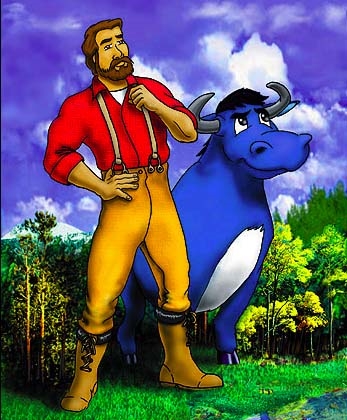
why is paul bunyan's cow blue?
Because he nearly froze to death before Paul found him. Here is one version of the story:
" Well now, one winter it was so cold that all the geese flew backward and all the fish moved south and even the snow turned blue. Late at night, it got so frigid that all spoken words froze solid afore they could be heard. People had to wait until sunup to find out what folks were talking about the night before.
Paul Bunyan went out walking in the woods one day during that Winter of the Blue Snow. He was knee-deep in blue snow when he heard a funny sound between a bleat and a snort. Looking down, he saw a teeny-tiny baby blue ox jest a hopping about in the snow and snorting with rage on account of he was too short to see over the drifts.
Paul Bunyan laughed when he saw the spunky little critter and took the little blue mite home with him. He warmed the little ox up by the fire and the little fellow fluffed up and dried out, but he remained as blue as the snow that had stained him in the first place. So Paul named him Babe the Blue Ox."
That's from here:










